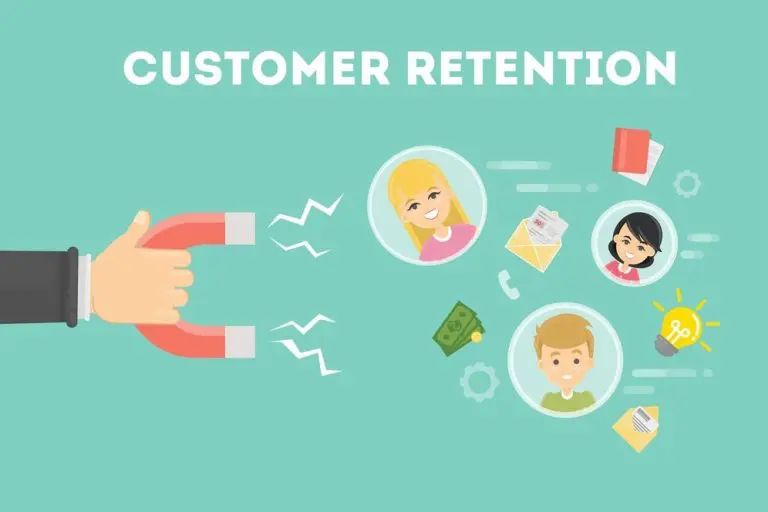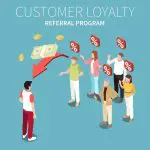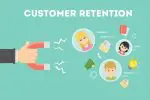Every business owner dreams of explosive growth. But what if the key to sustainable success isn’t about constantly chasing new leads? What if it’s about nurturing the relationships you already have?
Picture this: You’ve spent months (and a small fortune) wooing a potential client. Finally, they sign on the dotted line. You celebrate… then immediately start hunting for the next prospect. Sound familiar?
Here’s a shocking truth: This common approach is bleeding your business dry.
Studies show that acquiring a new customer can cost up to 5 times more than retaining an existing one. Yet, countless businesses pour resources into an endless cycle of customer acquisition, neglecting their most valuable asset: loyal customers. Uncover key strategies for retaining customers in 2024, focusing on nurturing loyalty and enhancing engagement with cost-effective, proven tactics.
But why does this matter? Because in today’s hyper-competitive landscape, customer retention isn’t just a nice-to-have – it’s the lifeblood of your business.
Think about it. Your existing customers already know you. They trust you. They’re primed to buy more, refer others, and stick with you through thick and thin. They’re not just customers; they’re brand ambassadors waiting to be activated.
So, why do so many businesses get this wrong? Because retention isn’t as sexy as acquisition. It doesn’t provide the same adrenaline rush as landing a new deal. But make no mistake – it’s where the real profit lies.
The Average Customer Retention
Average customer retention rates differ significantly across industries:
Insurance: 84%
Banking: 75%
Retail: 63%
Hospitality: 55%
SaaS: 35%
Save 80% of delivery management time
We handle everything:
- Dedicated operations manager
- Real-time tracking dashboard
- Automated customer notifications
- Urgent issue resolution
What Is Customer Retention?
Customer retention means keeping customers happy over time.
Businesses want to make sure customers buy again and stay loyal.
It’s cheaper to retain a customer than to get a new one.
Definition of Customer Retention
Customer retention is the act of keeping your customers engaged and satisfied so they continue to buy your products or use your services over time. The primary goal is to ensure not only repeat purchases but also build a sense of loyalty. Loyal customers are more likely to stick around, recommend your offerings to others, and contribute to long-term business and customer success. As reiterated by experts, “Acquiring a new customer is anywhere from five to twenty-five times more expensive than retaining an existing one.” This signifies the economic importance of customer retention as a cost-effective strategy.
Customer retention can take many forms. For instance, a coffee shop where the barista knows your name and your order creates a welcoming atmosphere, encouraging you to return. Similarly, a tech service that addresses issues promptly helps build trust, encouraging customers back.
Example(s) of Customer Retention
Examples of customer retention are all around us. Subscription services often increase interaction by offering exclusive content or bonuses, motivating customers to stay subscribed month after month. You should consider popular streaming services that not only provide new content regularly but also recommend shows based on previous viewing habits, ensuring users return. Retail loyalty cards are another example of a customer retention program, where customers receive discounts or rewards, making them more likely to choose the same store over its competitors.
Types of Customer Retention Strategies
Personalized Communication
Personalized communication involves adjusting your message to fit the needs and preferences of individual customers. By leveraging customer data, businesses can craft messages that resonate individually—such as sending birthday offers or discounts on frequently bought items. These personalized interactions make customers feel valued and understood, which strengthens the emotional connection to the brand. This tailored approach can range from personalized newsletters to proactive customer support that recognizes past interactions.
Continuous Feedback Loops
Feedback loops are central to understanding what your customers need and expect. Establish systems to gain regular insights from customers, which can be done through surveys, reviews, or direct feedback sessions. Collecting this data is only part of the strategy; implementing changes based on these insights is crucial for demonstrating that customer voices matter. When customers see tangible changes initiated by their feedback, trust increases, leading to deeper relationships and higher retention.
Benefits of Customer Retention
Spend less on getting new customers.
Loyal customers bring more business over time.
Better guesswork with finances.
Increased Revenue
When customers continue to choose a business, their purchasing habits evolve. They often spend more with each interaction. Businesses report that current customers spend 67% more than new customers. This is because they are familiar with the product and have less hesitation to buy. Notably, repeat customers not only purchase more but also require less convincing, saving on marketing costs.
Lower Acquisition Costs
Gaining new customers is expensive. Reports suggest it can cost up to five times more to attract a new customer than to keep an existing one. By focusing efforts on increasing customer retention, businesses can significantly cut down on expenses that typically go into advertising, promotions, and onboarding processes. This financial efficiency represents a clear benefit associated with focusing on existing customers.
Customer Acquisition Cost
Acquiring new customers is five times more expensive than retaining existing ones, highlighting the financial benefits of focusing on retention
Brand Advocacy
Loyal customers often become champions for the brand. When they spread the word, it leads to organic growth. Research shows that about 92% of people trust personal recommendations over any other form of advertising. These referrals, being free, offer invaluable advertising and increase customer bases naturally, while requiring zero marketing spend.
The Role of Social Proof
Word-of-mouth not only boosts sales but reinforces credibility. When satisfied customers talk about a brand, they lend their reputation to that endorsement. For further reading, Contagious: How to Build Word of Mouth in the Digital Age by Jonah Berger explores this in depth. In particular, Berger delves into how and why people share, which can help businesses nurture their brand advocates.
Predictable Cash Flow
Retained customers provide a steady income stream. Predictability here aids in precise financial forecasting. When a business can reliably predict cash coming in from existing clients, it can better plan for growth, and investments, and manage risks. Especially for subscription-based models, this predictability is key. Reliable revenue streams allow businesses the freedom to innovate without constantly eyeing fluctuating sales numbers.
Building Budget Accuracy
Knowing customer retention rates means businesses can project future earnings more accurately. This means less guesswork when planning budgets and setting financial goals. Also, a detailed understanding of customer behavior through tools like CRM systems can refine cash flow predictions further.
Enhanced Customer Insights
Retaining customers gives a business insights into their habits and needs over time. These insights help refine products or services to better fit their audience’s needs.
Personalization Possibilities
With ongoing relationships, businesses learn more about their customers. Personalized strategies build loyalty and keep clients happy. Marketing professor Philip Kotler discusses the importance of customization in his book, Marketing 4.0: Moving from Traditional to Digital. He notes that this adjustment from broad to individualized approaches will be crucial in maintaining a competitive edge in the modern market.
Competitive Advantage
Retention can act as a barrier for competitors. Businesses with a high retention rate typically hold a more significant market share. Competitors find it more challenging to lure away satisfied and loyal customers. These customers, thanks to their established trust and satisfaction, have less incentive to explore other options, shielding the company from constantly needing to fend off competitors’ efforts to snatch their customers-acquired client base.
Opportunities for Feedback and Improvement
Retained customers offer more consistent feedback. This feedback helps companies innovate and improve. Over time, ongoing interactions allow for the refinement of products and services. Initiatives based on direct consumer input can strengthen product relevance and increase customer retention.
Constant care and nurturing of customer relationships maximize these benefits. Smart strategies around make customer retention important not only improve business bottom lines but also foster a loyal clientele that grows organically.
Impact of Retention on Revenue
A mere 5% increase in customer retention can lead to a revenue increase of 25-95%
How Does Customer Retention Work?
Building trust with consistent service cements loyalty.
Providing ongoing value keeps customers engaged.
Building Trust and Relationships
Consistent Quality and Service Build Trust
Constant quality is the core of excellent customer service and trust. When a business maintains consistent standards, customers feel assured. According to a study, 96% of buyers say customer service is pivotal to loyalty. Trust is earned over time through each positive interaction. This doesn’t just happen overnight. Regularity and reliability create a trusted brand image. When customers can rely on the same high standards, they are more inclined to remain loyal.
Loyalty and Spending of Customers
Existing customers are 50% more likely to try new products and spend 31% more on average than new customers
Personal Connections Encourage Long-term Engagement
Personal connections make customers feel valued. It’s not just about selling a product; it’s about creating a relationship. These connections often go beyond mere transactions. They form when a business attends personally to customer needs, offering tailored solutions and communications.
Providing Value Over Time
Regularly Updating Products or Services
Continual value means evolving with your customers. Regular service or product updates keep customers interested and invested. Customers expect that their needs are considered and met promptly. Businesses must be proactive.
Ensuring Offerings Align with Customer Needs
Understanding customer needs is crucial. Aligning products with what customers want is a strategic move. Conduct surveys, gather data, and listen actively. Customer needs can shift, and businesses should be agile.
Encouraging Repeat Purchases
Creating Incentives for Loyalty
Repeat customers generate more revenue and retain customers. The data shows they spend 67% more than new customers. Incentives can fortify this behavior. Loyalty programs or discounts can provide significant impetuses. Rewards encourage repeated engagement. Keeping customers invested in your brand is often a matter of persistent incentives.
Customizing the Experience for Each Customer
Every customer’s journey should feel personalized. As mentioned earlier, personalized communication strengthens emotional bonds. Utilizing data can help provide tailored experiences. CRM systems can assist in this. They allow businesses to track customer preferences and behavior. “Predictive Analytics: The Power to Predict Who Will Click, Buy, Lie, or Die” by Eric Siegel is an essential resource on how data analytics can aid in this process. Customization fosters not just satisfaction but affinity toward your brand.
Effective Communication Channels
Using Multiple Channels to Engage
Communication is more than just emails. It’s about the right message at the right time, through the right platform. Integration across platforms guarantees a seamless customer experience. Social media, email, and live chat serve varied purposes. Each has its unique advantages. Customers need to know they can reach businesses swiftly, with 75% of customers highlighting speed as key. Bridging these channels cohesively is discussed in “Omnichannel Retail: How to Build Winning Stores in a Digital World” by Tim Mason and Miya Knights.
Maintaining Consistency Across Channels
A consistent narrative across all communication platforms maintains customer trust. If messages vary, it creates confusion. Consistency reassures customers. When they receive the same message everywhere, it strengthens reliability.
Rewarding Loyalty
Offering Exclusive Benefits
Exclusive benefits motivate long-term engagement. Customers who feel privileged or valued remain loyal. It’s different from regular transactions. These benefits can be early access to new products, exclusive discounts, or special loyalty tiers. It differentiates your brand and incentivizes ongoing engagement.
Recognizing Customer Milestones
Celebrating customer milestones reinforces loyalty. Recognizing birthdays, anniversaries, or purchase milestones shows appreciation. It’s a tangible acknowledgment of their importance to your brand. It also creates a personal touch that can’t be underestimated.
Correct data representation enhances customer perception and retains engagement. Loyalty begins with trust and evolves with consistent value delivery.
Importance of Customer Service
About 96% of buyers consider customer service as the primary factor behind their loyalty to a brand
How to Measure Customer Retention
-
Retention rate reveals how well you keep your customers.
-
Customer Lifetime Value (CLV) shows the profit a customer brings over time.
-
Accurate tracking improves your business decisions.
Step #1: Calculate Retention Rate
Retention rate is crucial. It tells you how many customers stick around after a period. The formula for this is straightforward:
Understanding the Formula
-
Formula: ((E-N)/S) x 100
-
E: Customers at the end of the period
-
N: New customers during the period
-
S: Customers at the start of the period
Tracking Over Time
Consistency counts. Measure regularly, whether monthly, quarterly, or yearly. Changes over time can show you trends. This helps in adapting strategies. An improvement in retention often leads to cost savings because keeping existing clients is cheaper than finding new ones.
Step #2: Monitor Customer Lifetime Value
CLV matters. It shows you the total business value a customer brings during their relationship with you. Here’s what you need to know about it:
Calculating CLV
CLV requires several pieces of data. Average purchase value, purchase frequency, and average repeat customer lifespan are key. Multiply these figures together to get CLV. For example, if a customer spends $100 per purchase, buys five times a year, and stays around for four years, their CLV is $2,000 ($100 x 5 x 4).
Utilizing CLV in Business Strategy
Knowing CLV helps in more ways than one. It allows you to segment customers based on their profitability. Adjust your resources towards high-value customers. Focus on improving their experience. This will often result in increased revenue because these customers tend to spend more over their lifetime. Retained customers typically spend 67% more than new ones.
Regular Updates
You should stay updated, review, and adjust CLV calculations regularly. As business models change, so should the CLV insights. This ensures your strategies remain aligned with profit expectations.
By measuring their customer retention rate and CLV, businesses can make informed decisions. It ensures the focus on those strategies that best enhance customer loyalty and profitability.
Tips for Improving Customer Loyalty and Customer Satisfaction
-
Strengthen customer loyalty through tailored programs.
-
Improve interactions to foster lasting relationships.
-
Use multiple channels for consistent engagement.
Develop Loyalty Programs For Your Existing Customers
Creating effective loyalty programs can significantly boost customer retention. Crafting these programs involves creating systems that reward repeat customers. Implementing point systems, where customers can accumulate points during purchases and redeem them for discounts or exclusive offers, is one approach. For instance, look at companies like Starbucks or Sephora, where loyalty programs have turned satisfied customers into brand advocates. While these programs seem straightforward, their success depends on a deep understanding of your customer base. Dive into data analytics to tailor rewards that resonate. Discover how to maintain a robust customer base with insights on marketing for retention, ensuring your loyalty programs continue to foster long-term relationships and repeat business.
Enhance Customer Experience
Improving customer experience is another crucial part of building loyalty. Simplify interactions by reducing unnecessary steps in the user journey. This means examining every touchpoint a customer has with your brand, from the initial website visit to customer support. You can aim to eliminate friction points where possible. Discover innovative retention strategies for ensuring customer loyalty, focusing on creating seamless experiences that keep clients coming back for more.
Customer support plays an essential role here. You should equip your support team with knowledge and tools to provide actionable solutions swiftly. Consider using AI-driven chatbots to handle routine inquiries, allowing human agents to tackle complex issues.
Engage on Multiple Platforms
Engaging with customers across various platforms enhances visibility and builds loyalty. Whether through social media, email marketing, or direct messaging, reaching out on different channels can maintain customer interest and engagement.
Consistent Branding
Maintain a coherent brand message across all channels. Inconsistency can lead to confusion and distrust. Tools such as CRM systems can ensure standardized communication. As Tony Hsieh wisely noted, “Satisfied customers will never be the most loyal customers to you. They’ll only be satisfied until a competitor does it better.” It underscores the importance of consistency in customer engagement.
Provide Personalization
Personalization tailors experience to individual customer needs, increasing satisfaction and loyalty. You can use customer data to personalize everything from product recommendations to content delivery. This targeted approach can turn one-time buyers into loyal advocates.
Using Data Responsibly
While personalization is vital, data privacy cannot be compromised. Transparency about data usage boosts trust, allowing customers to feel secure when sharing personal details. Transparency goes a long way in solidifying customer relationships.
Monitor and React to Customer Feedback
Customer feedback is a goldmine for insights into how your brand is perceived. Systematically collect and analyze feedback through surveys, reviews, and direct communications. More importantly, you should act on it. It is better to make tangible changes, showcase improvements, and communicate these back to customers.
Closing the Feedback Loop
Creating feedback loops strengthens trust. You should let customers know their voices have been heard and acted upon. This, in turn, enhances loyalty as customers recognize their input’s value.
What Are the Best Customer Retention Strategies?
-
Personalizing experiences boost customer satisfaction.
-
CRM systems enhance the management of customer interactions.
-
Regular feedback improves products and services.
Focus on Creating Personalized Experiences
In the realm of customer retention, personalizing experiences isn’t just beneficial—it’s necessary. Personalization means addressing the unique needs and preferences of each customer, which can significantly increase satisfaction and loyalty. By leveraging customer data—such as purchase history, browsing behavior, and demographic information—businesses can tailor marketing messages, offer relevant product recommendations, and create custom promotions.
More importantly, personalized experiences need to feel authentic. Tools like AI-driven recommendations and predictive analytics can help, but they require careful implementation.
Invest in a Robust CRM to Manage Customer Interactions
A well-chosen Customer Relationship Management (CRM) system acts as the backbone of any customer retention strategy. CRMs store all customer data in one place, providing invaluable insights into purchasing habits and engagement levels. Those insights allow for precise segmentation and targeted communication.
For instance, Salesforce reports that CRM systems can boost customer retention by 27% by ensuring that every interaction is consistent and informed. CRMs also automate follow-ups and reminders, reducing the chances of a customer churn or drop-out due to unattended issues or queries. It’s not just about collecting data—CRMs, when utilized effectively, transform data into actionable strategies that guide customer journey enhancements.
Modern CRMs come equipped with AI capabilities that analyze patterns and predict future behavior. This predictive aspect is critical, as it allows businesses to proactively address potential issues, even before the customer is aware.
Continuously Evaluate and Iterate Based on Feedback
Feedback mechanisms work as a direct line to your customers’ thoughts and concerns. Regularly collecting and analyzing feedback is akin to nourishing a plant—it needs to be frequent and consistent. More than 60% of companies view themselves as customer-centric, yet only 13% of customers agree. This gap highlights the importance of listening.
Constructing a robust feedback loop involves multiple channels—surveys, direct requests, and social listening. Beyond just collecting feedback, the key is to act on it. A study by Gartner shows companies that successfully analyze customer feedback can increase their growth rate by 25%.
There are challenges, though. Over-analyzing or hesitating to implement feedback can delay necessary changes. Balance is critical: either too frequent revisions or stagnant strategies can disturb customer expectations and brand consistency. Therefore, iterating on your offerings from feedback demands a strategic and thoughtful approach.
By focusing on these strategies, businesses can promote lasting customer relationships and drive retention beyond superficial engagements.
The Power of Customer Retention
Customer retention is not just a metric—it’s a growth engine. By focusing on keeping your existing customers happy and engaged, you’re not only securing a stable revenue stream but also creating brand advocates who will spread the word about your business. Remember, it’s often more cost-effective to retain a customer than to acquire a new one. As you implement personalized communication strategies, you should develop loyalty programs, encourage customers, and continuously improve based on feedback, you’ll see the compounding benefits of a loyal customer base.
The journey doesn’t end here. It’s time to take action to improve customer retention. It is better to start by calculating your current retention rate, and then choose one strategy from this article to implement immediately. Whether it’s enhancing your customer experience or launching a new feedback loop, every step towards better retention is a step towards sustainable growth. Your customers are waiting for you to show them how much you value their loyalty. Are you ready to transform your approach and reap the rewards of strong customer relationships?
Customer Retention Statistics
On average, it costs a business $243 to lose a customer, emphasizing the financial impact of churn.














